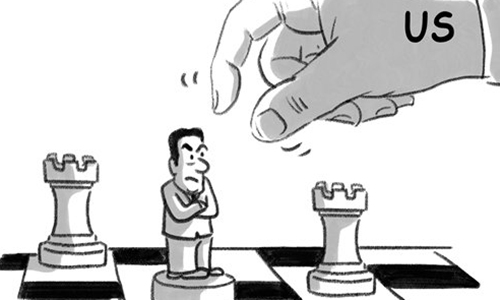HOME >> OPINION
US stirs regional conflict to stem China’s rise
By Li Haidong Source:Global Times Published: 2020/3/11 21:58:40

Illustration: Liu Rui/GT
Following the USS Carl Vinson's visit to Vietnam in 2018, the USS Theodore Roosevelt arrived in Da Nang, Vietnam, on March 5, marking the second visit of a US Navy aircraft carrier to the country since 1975. What is driving the US to conduct frequent military cooperation with Vietnam? What impact will it have?First, the US sees Vietnam's position in its Indo-Pacific Strategy within the framework of its comprehensive strategic competition with China. It has a clear strategy in dealing with the Southeast Asian country.
Washington has been advancing its planning for strategic competition with Beijing in various key areas. It has reassessed the roles that China's neighboring countries can play and adjusted policies accordingly.
The US has been attempting to cozy up to Vietnam. Since Philippine President Rodrigo Duterte notified the US in February that Manila would terminate the US-Philippines Visiting Forces Agreement, Washington has been considering improving Vietnam's position as a partner. The US intends to hedge against China's regional influence by stirring up conflicts between China and regional countries, such as Vietnam. In this way, the US can not only avoid a direct military conflict with China, but also achieve its goal of thwarting China's development by merely sacrificing its partners.
Second, the improvement in US-Vietnam military ties won't restrict US from attempting to transform Vietnam. One deep-rooted feature of US diplomacy is to carry out "peaceful revolutions" within socialist countries, by improving relations with these countries and then reshaping them or even overthrowing their governments.
Washington has long attempted to profoundly transform the socialist political system of Vietnam. For many US political elites, the failure to reshape Vietnam by war still stings. When the US deepens ties with Vietnam by fabricating a common enemy, it won't cease its impulsion to reshape the Southeast Asian country. And this will push Washington to enhance the evolution of Hanoi in all aspects with methods other than war.
The US has been helping Vietnam increase its military strength in recent years, with measures such as lifting decades-long arms ban, and gifting patrol ships. Washington has accelerated its attempt to reshape Hanoi in economic and political spheres through cooperation on security. Yet the Southeast Asian country will make its own judgment about the deep-rooted intention of the US.
Third, relevant parties are seeking solutions to the South China Sea issues via coordination and cooperation, and support the establishment of a regional community of a shared future to mitigate contradictions. The US is demonstrating the "legitimacy" of strengthening its ties with Vietnam and other regional countries in the South China Sea by sailing warships there. It has reflected its die-hard habit of attempting to resolve regional issues via military confrontation. The method has led to the complete failure of US Middle East and Afghanistan policies, with the interests of US allies being either severely compromised or sacrificed. The US itself is also divided and Washington has not yet learned the lesson.
The strengthening of US-Vietnam military ties will become a normal phenomenon. But the US aircraft carrier's visit to Vietnam will hardly change Vietnam's cooperative policy toward China. Given political mutual trust, economic collaboration and regional integration, a third party will hardly impact the overall stable relationship between Beijing and Hanoi. Increasing US military presence will not change the process of integration among regional countries or push China-US ties out of control.
The author is a professor with the Institute of International Relations, China Foreign Affairs University. opinion@globaltimes.com.cn
Posted in: VIEWPOINT,ASIAN REVIEW